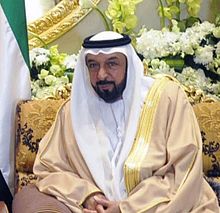| Khalifa Al Nahyan خليفة بن زايد آل نهيان | |||||
|---|---|---|---|---|---|
 Khalifa bin Zayed in 2013 | |||||
| 2nd President of the United Arab Emirates | |||||
| In office 3 November 2004 – 13 May 2022 | |||||
| Prime Minister | |||||
| Vice President |
| ||||
| Preceded by | Zayed bin Sultan Al Nahyan | ||||
| Succeeded by | Mohamed bin Zayed Al Nahyan | ||||
| Ruler of Abu Dhabi | |||||
| Reign | 2 November 2004 – 13 May 2022 | ||||
| Predecessor | Zayed bin Sultan Al Nahyan | ||||
| Successor | Mohamed bin Zayed Al Nahyan | ||||
| 2nd Deputy Prime Minister of the United Arab Emirates | |||||
| In office 23 December 1973 – 20 December 1977 | |||||
| President | Zayed bin Sultan Al Nahyan | ||||
| Prime Minister | Maktoum bin Rashid Al Maktoum | ||||
| Preceded by | Hamdan bin Rashid Al Maktoum | ||||
| Succeeded by | Hamdan bin Mohammed Al Nahyan | ||||
| Born | 7 September 1948 Al Ain, Abu Dhabi, Trucial States | ||||
| Died | 13 May 2022 (aged 73) Abu Dhabi, United Arab Emirates | ||||
| Burial | Al Bateen Cemetery[1] | ||||
| Spouse | [2] | ||||
| Issue Detail |
| ||||
| |||||
| House | Al Nahyan | ||||
| Father | Zayed bin Sultan Al Nahyan | ||||
| Mother | Hassa bint Mohammed Al Nahyan | ||||
Education | |||||
| Religion | Sunni Islam | ||||
Sheikh Khalifa bin Zayed bin Sultan Al Nahyan (Arabic: خليفة بن زايد بن سلطان آل نهيان; 7 September 1948 – 13 May 2022)[3][4] was the second president of the United Arab Emirates and the ruler of Abu Dhabi, serving from November 2004 until his death in May 2022.[5]
Khalifa was the eldest son of Zayed bin Sultan Al Nahyan, the first president of the United Arab Emirates. As crown prince of Abu Dhabi, Khalifa carried out some aspects of the presidency in a de facto capacity from the late 1990s when his father experienced health problems.[6] He succeeded his father as the ruler of Abu Dhabi on 2 November 2004, and the Federal Supreme Council elected him as president of the UAE the following day. As ruler of Abu Dhabi, he attracted cultural and academic centres to Abu Dhabi, helping establish the Louvre Abu Dhabi, New York University Abu Dhabi and Sorbonne University Abu Dhabi. He also established Etihad Airways.[7]
During Khalifa's presidency, the United Arab Emirates became a regional economic powerhouse and its non-oil economy grew.[8][7] Khalifa was viewed as a pro-Western modernizer whose low-key approach helped steer the country through a tense era in regional politics and forged closer ties with the United States and Israel.[9] As president during the financial crisis of 2007–2008, he directed the payment of billions of dollars in emergency bailout funds into Dubai.[7] On 4 January 2010, the world's tallest man-made structure, originally known as Burj Dubai, was renamed the Burj Khalifa in his honor.[10]
In January 2014, Khalifa had a stroke and was in stable condition after surgery.[11] He then assumed a lower profile in state affairs but retained ceremonial presidential powers. His half-brother Mohamed bin Zayed Al Nahyan carried out public affairs of the state and day-to-day decision-making of the Emirate of Abu Dhabi.[12] In 2018, Forbes named Khalifa in its list of the world's most powerful people.[13] Following his death on 13 May 2022, Khalifa was succeeded by his brother Mohamed.
- ^ "UAE President Sheikh Khalifa laid to rest". The National. 13 May 2022. Retrieved 14 May 2022.
- ^ "Memories of Abu Dhabi and Al Ain in the Early Nineteen-Sixties" (PDF). National Archives. Archived from the original (PDF) on 26 May 2018. Retrieved 28 May 2021.
- ^ "UAE President Sheikh Khalifa bin Zayed passes away". Khaleej Times. Retrieved 13 May 2022.
- ^ "UAE President Sheikh Khalifa bin Zayed passes away on 13 May 2022 at the age of 73". gulfnews.com. 13 May 2022. Retrieved 13 May 2022.
- ^ "Sheikh Khalifa ibn Zayed Al Nahyan | Biography, Family, & Facts". Encyclopedia Britannica. Retrieved 31 August 2021.
- ^ "H. H. Sheikh Khalifa bin Zayed Al Nahyan". United Arab Emirates. Retrieved 30 March 2021.
- ^ a b c "UAE president Sheikh Khalifa bin Zayed Al Nahyan dies aged 73". The Guardian. 13 May 2022.
- ^ "The UAE economy's transformation under Sheikh Khalifa's leadership". The National. 14 May 2022.
- ^ "Modernising UAE leader Khalifa moved UAE closer to U.S." Reuters. 13 May 2022.
- ^ "World's tallest building opens in Dubai". BBC News. 4 January 2010. Retrieved 11 April 2013.
- ^ "Sheikh Khalifa's condition stable as he recovers from stroke". The National. Abu Dhabi. 25 January 2014. Retrieved 16 July 2014.
- ^ "UAE president stable after suffering stroke". Financial Times. 26 January 2014.
- ^ "The World's Most Powerful People". Forbes. Retrieved 6 September 2021.